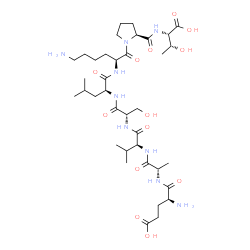182683-50-7
| Name | PKCε Inhibitor Peptide |
|---|---|
| Synonyms |
L-Threonine, L-α-glutamyl-L-alanyl-L-valyl-L-seryl-L-leucyl-L-lysyl-L-prolyl-
L-α-Glutamyl-L-alanyl-L-valyl-L-seryl-L-leucyl-L-lysyl-L-prolyl-L-threonine PKCε Inhibitor Peptide |
| Description | Epsilon-V1-2 (ε-V1-2), a PKCε-derived peptide, is a selective PKCε inhibitor. Epsilon-V1-2 inhibits the translocationof PKCε, but not α-, β-, and δPKC[1]. |
|---|---|
| Related Catalog | |
| Target |
PKCε |
| In Vitro | Epsilon-V1-2 (ε-V1-2), a PKCε-derived peptide containing the site for its specific receptor for activated C kinase (RACK), inhibits translocation of PKCε and reduces insulin response to glucose[1]. Epsilon-V1-2 (ε-V1-2; 1 µM, 24 hours) treatment significantly inhibits Oleic acid (OA)-induced connexin 43 (Cx43) Ser368 phosphorylation and prevents OA-induced gap junction disassembly in cardiomyocytes[2]. |
| In Vivo | Epsilon-V1-2 (20 mg/kg/day; osmotic pumps; daily; for 4 weeks) treatment significantly improves the beating score in a murine heterotopic transplantation model. Epsilon-V1-2 reduces infiltration of macrophages and T cells into the cardiac grafts, and decreases parenchymal fibrosis. Epsilon-V1-2 treatment almost abolishes the rise in pro-fibrotic cytokine, TGF-β and monocyte recruiting chemokine MCP-1 levels[3]. Animal Model: C57BL/6J mice transplanted the hearts of FVB mice[3] Dosage: 20 mg/kg/day Administration: 0.1 mL osmotic pumps implanted subcutaneously; daily; for 4 weeks Result: Significantly improved the beating score throughout the treatment. |
| References |
| Density | 1.3±0.1 g/cm3 |
|---|---|
| Boiling Point | 1280.1±65.0 °C at 760 mmHg |
| Molecular Formula | C37H65N9O13 |
| Molecular Weight | 843.964 |
| Flash Point | 728.0±34.3 °C |
| Exact Mass | 843.470154 |
| LogP | -1.22 |
| Vapour Pressure | 0.0±0.6 mmHg at 25°C |
| Index of Refraction | 1.552 |

